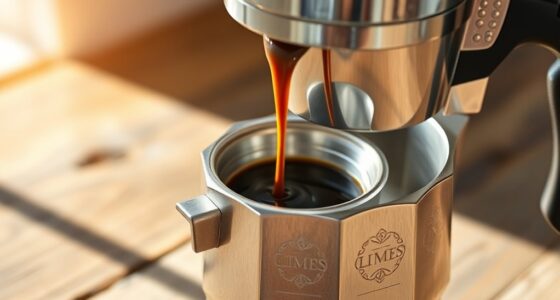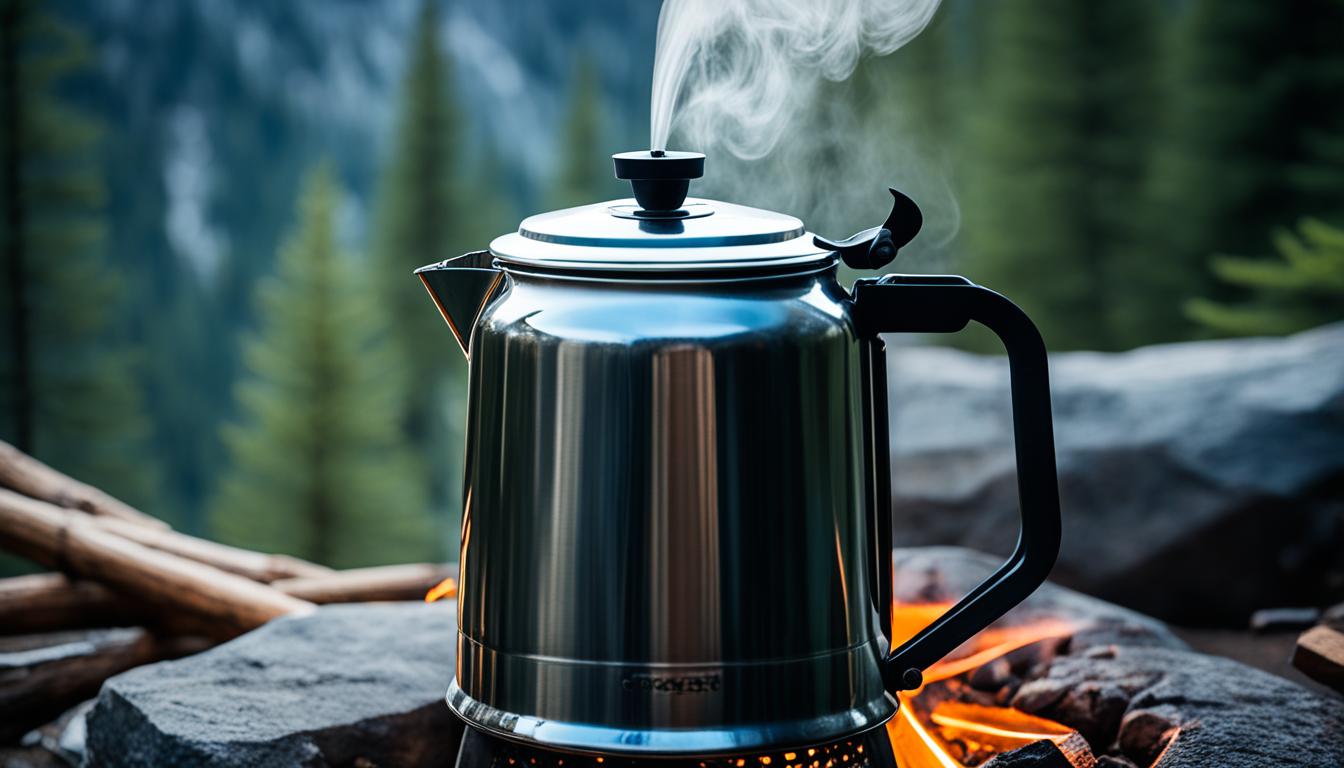To brew drip coffee that truly shines, choose a filter that suits your flavor preference and brewing style. Paper filters create a clean, bright cup by trapping oils and sediments, while metal and cloth filters allow more oils and particles for a richer, fuller-bodied brew. The shape also impacts extraction; cones promote brighter flavors, while flat-bottom filters produce balanced results. For the best results, learn how to select, rinse, and maintain your filters—all covered in the full guide.
Key Takeaways
- Choose paper filters for a clean, bright cup; opt for unbleached to preserve natural flavors and reduce papery notes.
- Use metal or reusable filters for a fuller-bodied, aromatic brew with more oils and sediment, enhancing richness and depth.
- Select cone or tapered filters for slower extraction and brighter, more nuanced flavors; flat-bottom filters yield balanced, full-bodied coffee.
- Regularly clean and rinse filters thoroughly to prevent oil buildup and mineral deposits, ensuring optimal flow and flavor clarity.
- Properly dry and store your filters in a breathable space to maintain hygiene and prevent mold, preserving the quality of your brew.
Understanding Different Filter Materials and Their Impact on Coffee Flavor
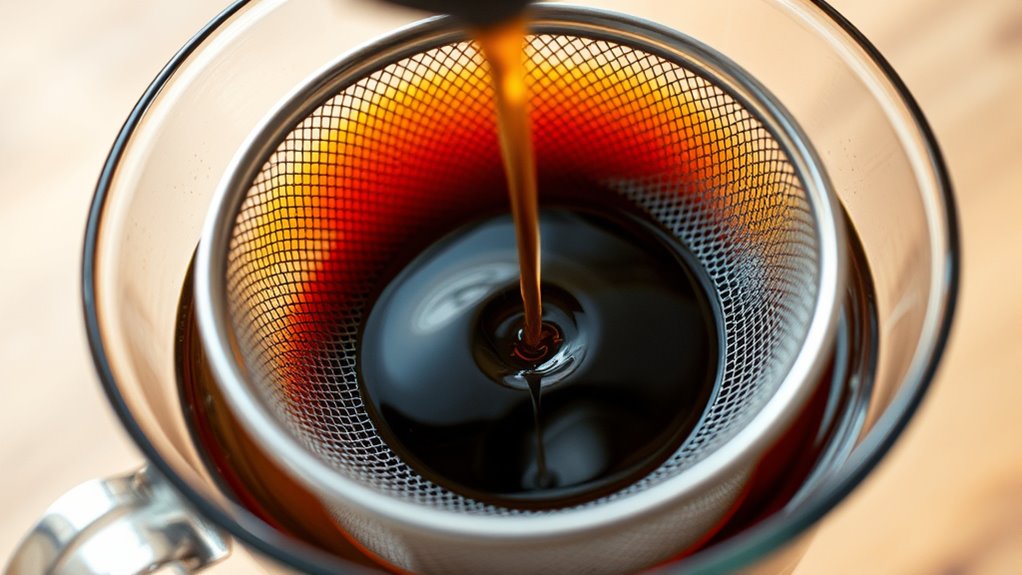
Choosing the right filter material substantially influences your coffee’s flavor. The type of filter material determines how much oil, sediment, and tiny grounds pass into your brew, shaping the flavor profile. Paper filters, especially unbleached brown ones, produce a clean, bright cup by trapping oils and sediments, giving a lighter taste. Bleached white filters might add a subtle papery note if not rinsed properly. Metal filters, made of fine mesh, let more oils and particles through, resulting in a richer, fuller-bodied flavor with enhanced aroma. Cloth filters, often from cotton or hemp, filter out fine grounds but allow oils to pass, creating a smooth, complex brew. Your choice of filter material directly impacts clarity, richness, and overall coffee experience—helping you brew the best cup every time. Modern filter options also incorporate efficiency ratings, which can influence how well the filter performs in different brewing conditions.
Exploring the Advantages and Disadvantages of Paper Filters
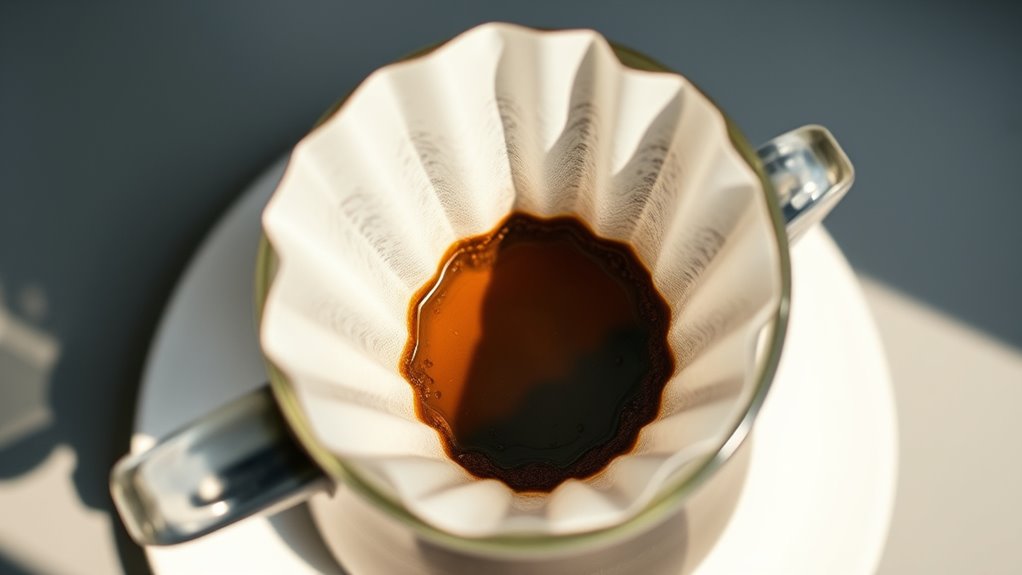
Paper filters are widely favored for their ability to produce a clean, bright cup by effectively trapping oils and fine particles, which results in less sediment and a clearer brew. Their sediment retention capability guarantees you get a smooth coffee with minimal grit, enhancing the overall flavor clarity. However, the tight weave and thickness of paper filters can slow down the brew time and influence extraction, sometimes leading to a slightly muted flavor. Bleached filters may leave a subtle papery taste, while unbleached filters tend to preserve a more natural flavor profile. Rinsing the filters beforehand helps reduce unwanted flavors and improves consistency. Keep in mind, paper filters generate waste, making them less eco-friendly than reusable options, a consideration if sustainability matters to you. Additionally, choosing appropriate filter size ensures optimal flow and brewing efficiency.
The Benefits of Metal Mesh Filters for Reusable Brewing
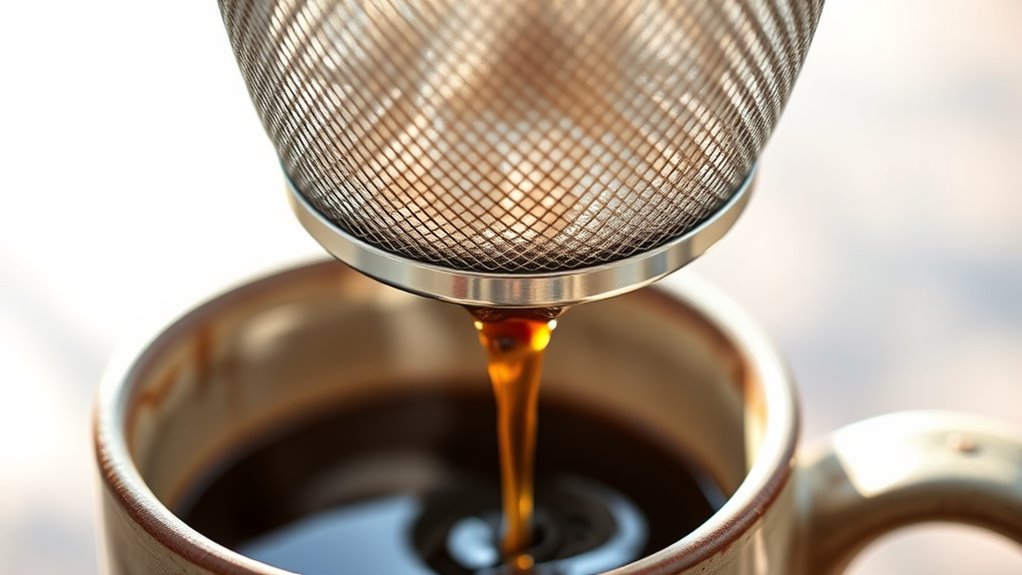
Metal mesh filters offer an eco-friendly alternative to disposable options by allowing you to reuse them repeatedly, which helps reduce waste. With reusable brewing, you can enjoy a fuller-bodied, more aromatic coffee because the porous metal design lets coffee oils and fine particles pass through. This enhances flavor and richness compared to paper filters that trap these oils. Proper cleaning is essential; a thorough rinse and occasional use of cleaning powders like Cafiza keep residue buildup at bay. Keep in mind, metal filters may produce a slightly cloudy cup due to their larger pores, allowing some grounds through. Their durability means long-term use and cost savings, making them a smart choice for eco-conscious coffee lovers who appreciate full flavor and sustainability. Additionally, the automatic cleaning functions of some smart toilets can help maintain hygiene with minimal effort.
How Cloth Coffee Filters Influence Taste and Texture
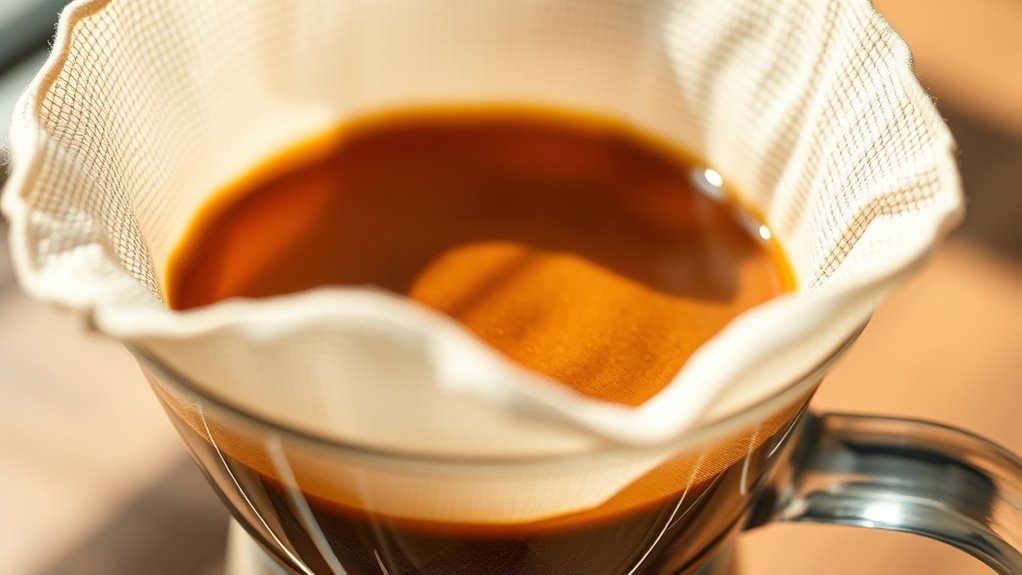
Cloth coffee filters considerably influence the flavor and texture of your brew by allowing more oils and fine particles to pass through, resulting in a richer and fuller-bodied cup. These cloth filters, often made from cotton or hemp, enhance the flavor profile by emphasizing nuanced notes and adding depth. They also improve the brewing texture, producing a smooth, viscous mouthfeel without cloudiness, thanks to their fine weave that traps minimal sediment. Proper maintenance, including thorough washing and drying, is essential to prevent mold and bacteria that could affect taste. Over time, cloth filters develop a natural patina, subtly shifting aroma and texture. Additionally, the type of cloth material can subtly influence the dog names associated with your brewing style, reflecting your personal taste and aesthetic. Overall, cloth filters deliver a distinctive sensory experience, elevating your coffee with richer oils and a more satisfying mouthfeel.
Comparing Filter Shapes: Flat-Bottom vs. Cone Designs
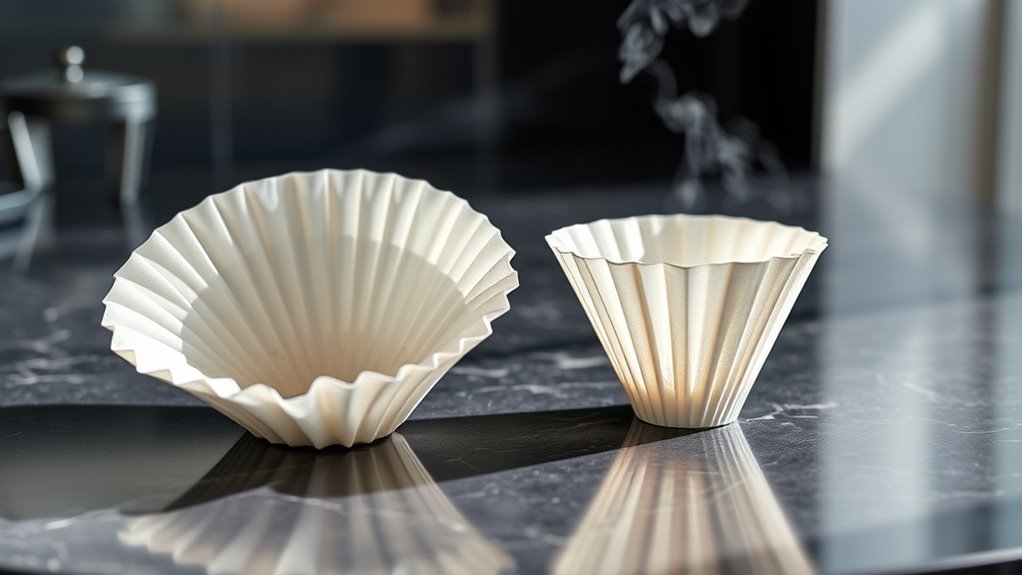
When choosing between filter shapes, understanding their impact on brewing can help you achieve your ideal cup. Cone filters promote a slower, more thorough extraction thanks to their tapered design, often resulting in brighter, more acidic flavors. They create a deeper coffee bed, encouraging complex extraction and emphasizing nuanced, aromatic profiles. Flat-bottom filters, on the other hand, offer a larger surface area and faster water flow, producing a fuller-bodied brew with balanced flavors. They generate a shallower bed, which ensures consistent extraction and is favored in automatic drip machines for everyday use. Your choice influences brew quality: cone filters excel for detailed, delicate coffees, while flat-bottom filters deliver reliable, full-flavored results. Selecting the right shape aligns your brewing style with your flavor preferences. Additionally, the filter shape can impact the overall extraction process, affecting the clarity and richness of your final cup.
Factors to Consider When Selecting the Perfect Coffee Filter
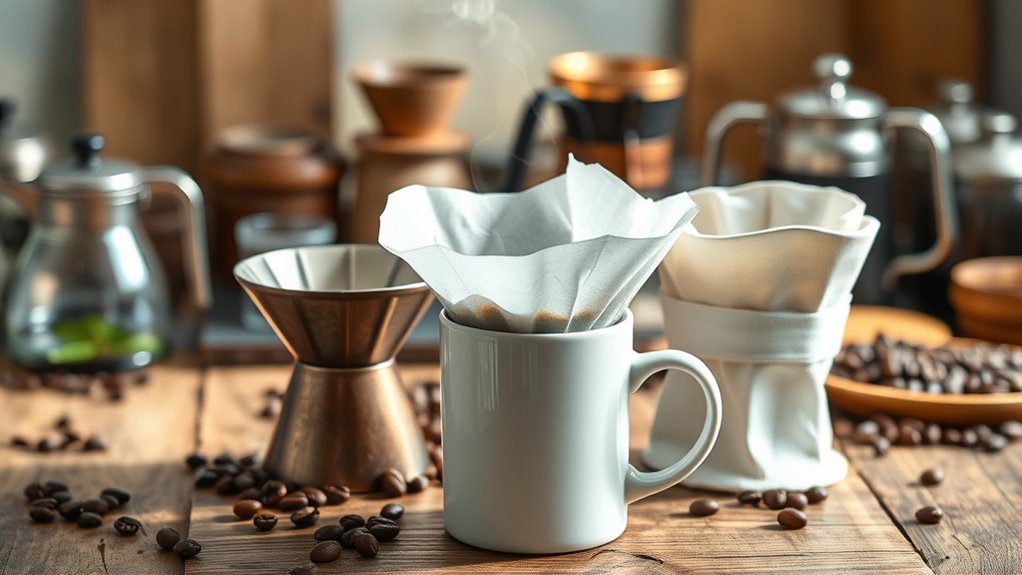
Choosing the right coffee filter depends on several key factors that directly affect your brewing experience. First, verify the filter is compatible with your brewing method, such as pour-over, drip machine, or French press, to guarantee proper fit and extraction. Material choice considerably impacts flavor, cleaning, and environmental impact—options include paper, metal, or cloth. The filter’s flow rate also matters; filters with larger pores or thinner material allow water to pass faster, influencing extraction time and taste. Consider cost and reusability: disposable paper filters are budget-friendly but generate waste, while metal and cloth filters are more eco-friendly but require upfront investment. Your taste preferences, clarity, and brew strength should guide your selection. Additionally, filter material influences both the flavor profile and ease of maintenance, which can enhance your overall brewing satisfaction.
The Role of Flow Rate in Achieving Optimal Extraction
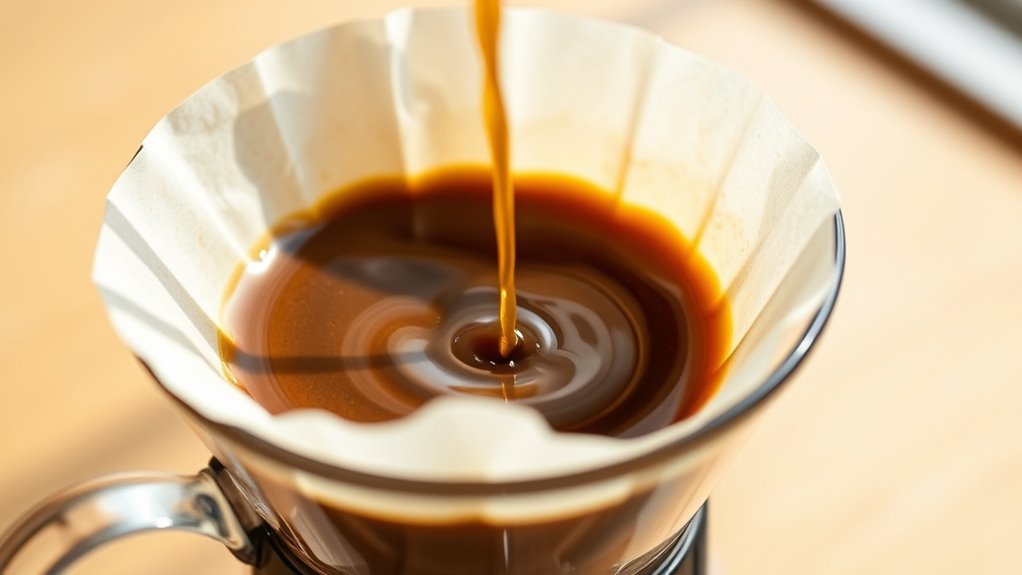
The flow rate of water through your coffee filter plays an essential role in determining the quality of your brew. A balanced flow rate ensures proper extraction, allowing flavors to develop fully. If water moves too slowly, over-extraction occurs, making the coffee bitter and harsh. Conversely, a fast flow rate can cause under-extraction, resulting in weak, sour, or underdeveloped flavors. The filter material and its porosity directly influence this flow rate by controlling how quickly water passes through. Choosing a filter with the right permeability helps you find the ideal extraction balance. Keep in mind that grind size also impacts flow rate: finer grounds slow it down, while coarser grounds speed it up. Achieving the right flow rate is key for a flavorful, well-rounded cup. Additionally, understanding regional divorce statistics can offer insights into how various factors influence outcomes, much like selecting the proper filter material impacts your brew.
Rinsing and Preparing Your Coffee Filter for Better Results

Rinsing your coffee filter before brewing is a simple step that considerably improves your coffee’s clarity and flavor. Using hot water to rinse the filter helps remove residual papery tastes and enhances the overall filter preparation. This quick step also improves flow rate by moistening the filter, preventing it from absorbing water during brewing. For metal filters, rinsing removes dust, oils, and manufacturing residues that could impact taste. Cloth filters should be thoroughly rinsed and soaked in hot water after each use to eliminate oils and prevent mold. Proper rinsing ensures ideal extraction, reduces unwanted flavors, and results in a cleaner, more refined cup of coffee. Additionally, filter maintenance is essential for maintaining freshness and performance over time.
Tips for Maintaining and Cleaning Your Coffee Filters
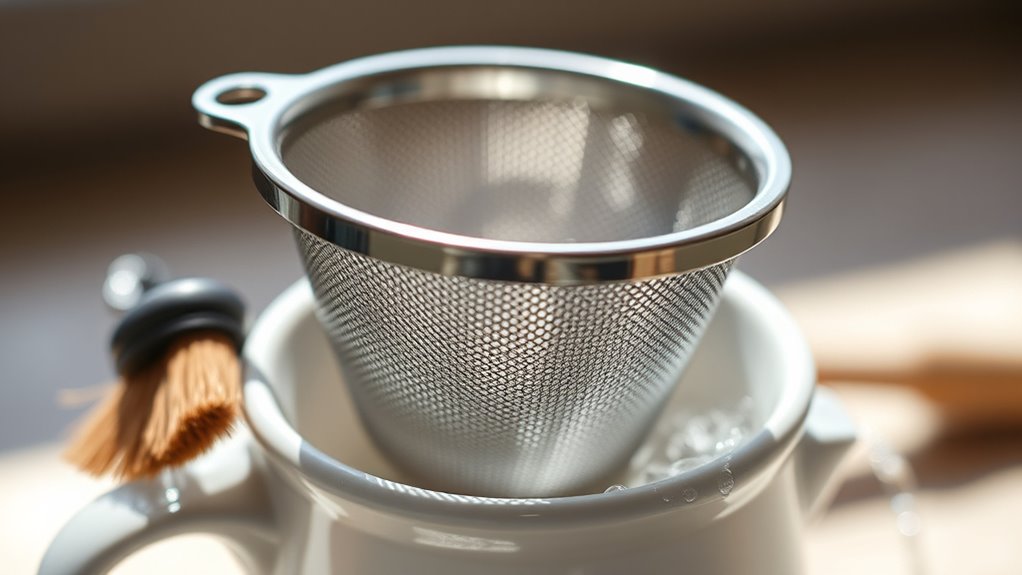
To keep your coffee filters working their best, regular deep cleaning is essential. Make sure to dry cloth filters thoroughly and avoid residue buildup that can affect flavor. Proper maintenance will extend their lifespan and ensure every brew tastes fresh. Incorporating fabric decorating markers can also help personalize and label your filters for easy identification and care.
Regular Deep Cleaning
Regular deep cleaning of your coffee filters is essential for maintaining their performance and guaranteeing great-tasting brews. It prevents oil buildup, mineral deposits, and bacteria that can spoil flavor. For removable filters, monthly deep cleaning with vinegar or descaling solutions keeps them free of residue, ensuring ideal flow and taste. Cloth filters should be rinsed thoroughly and dried after each use to prevent mold, while metal filters benefit from immediate rinsing to maintain clarity. Paper filters should be disposed of promptly to preserve their absorbent quality and avoid clogging. Regular sterilization by boiling or dishwasher cycles extends their lifespan and keeps them hygienic. Consistent filter maintenance guarantees a fresh, flavorful coffee experience every time. Celebrity lifestyles influence trends in home decor, including how some opt for custom-designed coffee setups.
Proper Drying Techniques
Proper drying techniques are essential for maintaining the cleanliness and longevity of your coffee filters. After cleaning, rinse cloth and metal filters thoroughly with hot water to remove residual oils and prevent mold growth. Allow these filters to air dry completely in a well-ventilated area before storing, which helps inhibit bacteria and mildew formation. For cloth filters, consider soaking in a vinegar solution (1 part vinegar to 4 parts water) periodically for deep cleaning and odor removal, then rinse thoroughly. Avoid drying filters in direct sunlight for extended periods, as UV exposure can degrade the material over time. Once dry, store your filters in a breathable container or bag to prevent moisture buildup. Proper drying is a key part of filter maintenance and cleaning, ensuring your filters stay fresh and functional.
Avoiding Residue Buildup
Avoiding residue buildup is essential for maintaining the flavor and flow of your coffee. Regular cleaning prevents oils and residues from accumulating, which can impair taste and clog filters. For metal filters, remove and wash them often to keep them free of residue buildup. Rinse paper filters thoroughly with hot water before use to cut down on papery taste and residue. Use a mild, non-abrasive cleaning solution or vinegar soak periodically to dissolve mineral deposits and residual oils from reusable filters. Never leave used filters in the sink or dry them improperly, as moisture fosters mold and bacteria growth. Consistent cleaning is key—schedule weekly deep cleans for reusable filters to ensure peak performance and fresh-tasting coffee.
- Remove and clean metal filters regularly
- Rinse paper filters thoroughly before brewing
- Use vinegar or gentle cleaners periodically
- Never leave used filters in the sink or wet
- Stick to a cleaning schedule for best results
Frequently Asked Questions
How Do I Know Which Coffee Filter to Buy?
You wonder which coffee filter to buy? First, consider your brewing method—cone filters suit pour-over, while flat-bottom filters work best in automatic machines. Think about taste preferences; paper filters give a cleaner cup, metal filters add richness. Check your coffee maker’s size and shape requirements, and consider environmental impact—reusable filters cut waste. finally, factor in convenience—disposable filters are easy, but reusable ones save money long-term.
What Filters to Use for Drip Coffee?
Think of your coffee filter as the gatekeeper to flavor. If you want bright, lively notes, choose a cone-shaped paper filter like Hario V60. For a balanced, smooth brew, opt for flat-bottom basket filters like Kalita Wave. If you prefer a richer cup, metal filters let more oils through. Match your filter to your brewing method and taste, ensuring a perfect flow that releases your coffee’s true character.
How to Make the Best Tasting Drip Coffee?
To make the best-tasting drip coffee, start with freshly ground coffee at a medium grind size for ideal extraction. Use water between 195°F and 205°F, pouring it evenly over the grounds to guarantee uniform flavor. Select high-quality, compatible filters to prevent off-flavors. Let the coffee fully drip through before serving, allowing the flavors to develop fully and delivering a clean, rich taste with every cup.
Does the Quality of a Coffee Filter Matter?
Yes, the quality of your coffee filter definitely makes a difference. Finer, higher-quality filters trap tiny grounds and sediment, guaranteeing a cleaner, clearer cup. They also prevent unwanted flavors from seeping in, preserving your coffee’s natural aroma. Poor filters can produce papery or metallic tastes that tarnish your brew. So, by choosing quality filters, you guarantee a smoother, more satisfying sip, transforming ordinary coffee into an extraordinary experience.
Conclusion
Choosing the right filter can transform your coffee experience. Did you know that using a metal mesh filter can reduce paper waste by up to 90%? By understanding your options and maintaining your filters properly, you’ll enjoy richer flavor and cleaner cups every time. So, experiment with different materials and shapes—your perfect brew is just a filter away. Start making those small changes today for a more flavorful, eco-friendly coffee journey.



